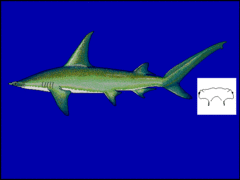Great hammerhead
2007 Schools Wikipedia Selection. Related subjects: Insects, Reptiles and Fish
| iGreat hammerhead | ||||||||||||||||
|---|---|---|---|---|---|---|---|---|---|---|---|---|---|---|---|---|
 |
||||||||||||||||
|
|
||||||||||||||||
|
Data deficient (DD)
|
||||||||||||||||
| Scientific classification | ||||||||||||||||
|
||||||||||||||||
|
|
||||||||||||||||
| Sphyrna mokarran ( Rüppell, 1837) |
The great hammerhead, Sphyrna mokarran, is the largest species of hammerhead shark. It is found worldwide in coastal areas and above continental shelves in warm and tropical waters to depths of 80 m (260 ft).
Anatomy and appearance
It is easy to confuse the great hammerhead with the smooth hammerhead, Sphyrna zygaena, since both are very large hammerhead sharks.
The great hammerhead has a thick head in which the eyes are located at the margins. It has a dark brown to light grey dorsal surface: this colour can be olive as it fades into the underside of the sharks which is a lighter off-white colour.
A typical great hammerhead grows to 4 m in length and can weigh around 230 kg (500 lb). The largest reported length is 6.1 m, and the largest ever caught weighed 580 kg (1,280 lb) and was 4.4 m (14.5 ft) long, caught in Boca Grande, Florida. However, this was a pregnant species, bearing 55 near-natal pups, which have obviously added to the weight.
Expected life span of this species is approximately 20 to 30 years of age.
Diet
Great hammerheads eat small sharks, rays and sting rays, squid and bony fish. The great hammerhead has a defense against the venom of sting rays, which seem to be a particular favorite in their diet. They will kill stingrays by using their hammer shaped head to pin them down while they bite the wings off the ray. They often skim the bottoms of oceans and stir up the sand with their heads, mouths open, to consume their prey. They hunt alone.
Behaviour
When encountered by divers, the great hammerhead is usually quite shy and normally not aggressive. The International Shark Attack File classifies the great hammerhead as one of the least dangerous sharks with only one provoked attack, but an unspecified hammerhead which might include the great hammerhead is on seventh place, so this shark is to be considered dangerous but not extremely aggressive.
Reproduction
Great hammerheads are viviparous. They give birth to a litter of between 6 and 55 young, typically 20 to 40. The gestation period is 11 months. Size at birth is about 60 to 70 cm. Females mature at about 2.1 to 2.5 m and males at about 2.25 to 2.7 m.